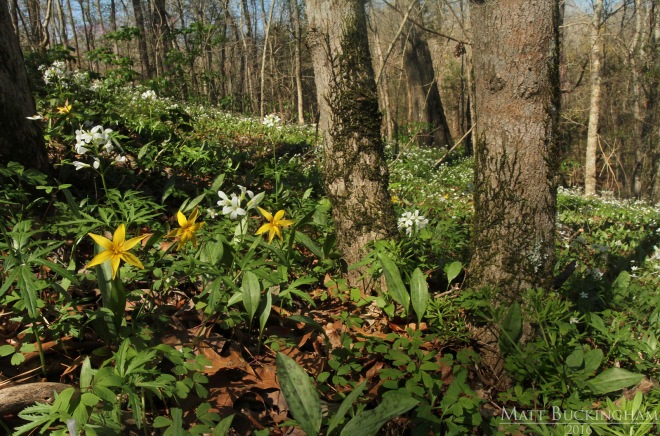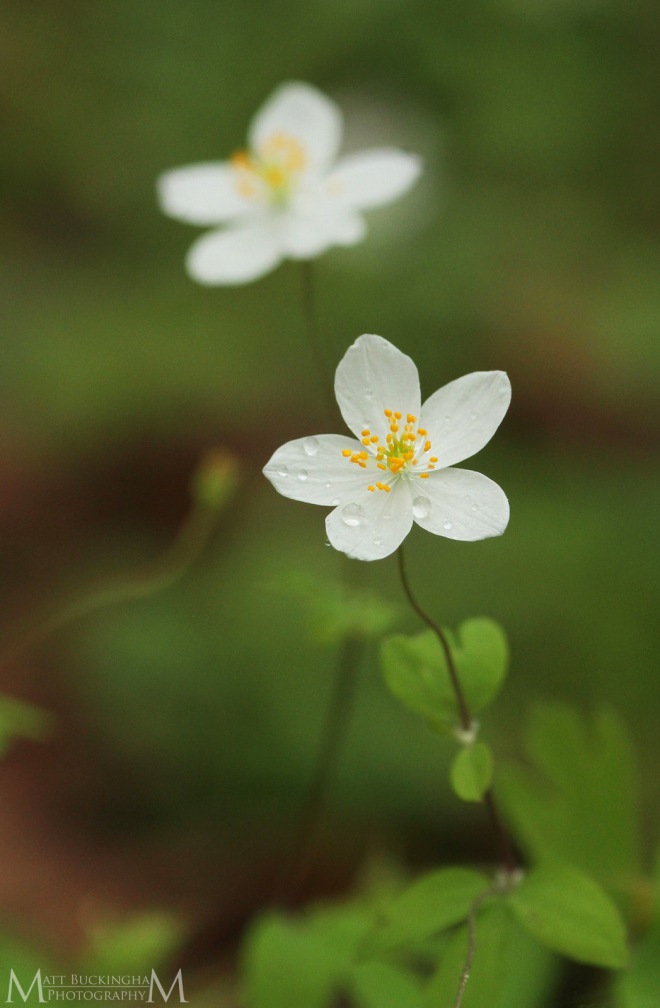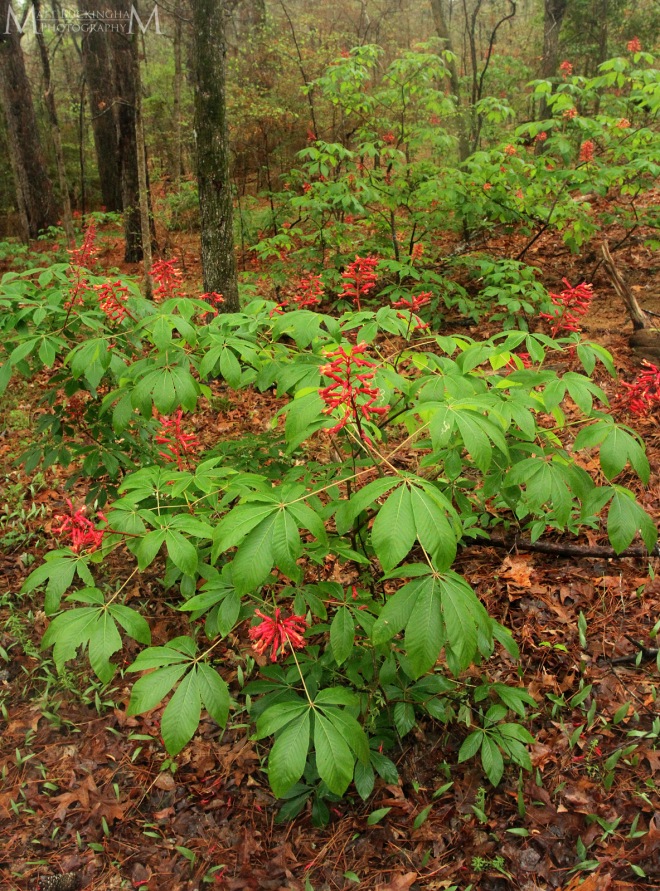
False Rue Anemone
I’m going to break my own rule again and make a post that is not about a species on my 2017 list of biodiversity goals to tell you about what may be, in my opinion, the nicest patch of forest in all of Texas. A couple of years ago Carolina and I were fortunate enough to meet Susan and Viron through a mutual friend. We joined them on a hike through the Sabine National Forest and it became clear that we were meant to be friends. They shared our love for exploring wild places. During our hike they talked about the property they owned in East Texas. They mentioned some plants that they had on their property including bloodroot and trout lily, and naturally my ears perked up. We parted ways with a promise to explore their land to see what other treasures it might hold.
We got our chance the next spring, and visited them at their home – a log cabin that they built themselves – nestled on a high ridge overlooking a steep, scenic slope. As we approached the house I could already begin seeing drifts of Yellow Trout Lily (Erythronium rostratum) and clumps of Sabine River Wakerobin (Trillium gracile). After visiting for a while we set out to explore.

A mesic calcareous slope on private land rich in spring ephemeral forbs that are rare in Texas. Taken in March 2016
They took us down a trail that lead away from the house. It climbed to the top of a hill covered in Mayapple (Podphyllum peltatum), and as we crested the ridge I was not prepared for the view that lay before me. I saw a steep slope that was literally carpeted with thousands of spring ephemeral herbs that were flowering in spectacular profusion. Thousands of Yellow Trout Lilies and Cutleaf Toothworts (Cardamine concactenata) had opened their blooms. Both species are rare in Texas. The scene seemed more appropriate for the slopes of the Great Smoky or Blue Ridge Mountains than East Texas.
There was also a species growing among them that I did not immediately recognize. It turned out to be False Rue Anemone (Enemion biternatum), and I was unsure if it had been previously documented in Texas. After returning home that evening I sent an e-mail to Jason Singhurst, the state botanist with TPWD and began doing a little research. It turned out to be the second documented population in the state. Having found the only other population, Jason was anxious to get out and explore the property to document this population and see what else this wonderful land might harbor.

False Rue Anemone
He got his chance a couple of days ago on a warm, rainy spring day. Jason and a group of excellent botanists joined me on the property, and while it rained on and off throughout the day, I could not find it in me to complain about the weather. To me, days like this are the epitome of spring in the eastern forests. Like me, Jason and the others could not believe their eyes. After arriving we soon located the False Rue Anemone which was blooming by the thousands.
The mesic, calcareous slopes turned out to be far more extensive than I originally thought, stretching for acres across the property. Perhaps the most dominant spring ephemeral forb was the Yellow Trout Lily, which had sent up hundreds of thousands of leaves. While there were several blooms they remained closed throughout the day, as they only open under warm, bright conditions. Fortunately I was able to photograph this species at the site the previous year. Yellow Trout Lily is rare in Texas, known only from a few high quality mesic forests. It is one of a few yellow-flowered in Eastern North America. It is easily differentiated by the others by its erect flowers and tepals (combination of petals and sepals) that are not reflexed.

Yellow Trout Lily. Taken in March 2016
Perhaps even more rare than the Yellow Trout Lily is the Cutleaf Toothwort. It too was blooming by the thousands here. This rare member of the mustard family (Brassicaceae) is a typical flower of eastern deciduous forests that is only known from a few locations in Texas. It is one of the hosts for the Falcate Orangetip (Anthocharis midea). Though we saw many of these beautiful butterflies during our visit, they were impossible to photograph as they refused to pause while bouncing from flower to flower in their quest for nectar.

Cutleaf Toothwort. Taken in March 2016
Several flowering groups of Wild Blue Phlox (Phlox divaricata) were also present. This showy phlox is rare in Texas, where it reaches the southwestern periphery of its range. However it can be downright abundant in the hardwood forests of the Appalachians and eastern North America.

Wild Blue Phlox
The rain presented several unique photographic opportunities. The day must have been just warm enough for the Bloodroot (Sanguinaria canadensis) to open. We found several of this quintessential forb of the eastern deciduous forest. I captured this photogenic plant with fresh raindrops on the petals. Like so many of the other plants at this site, Bloodroot is rare in Texas. Probably never particularly common, it has suffered through more than a century of habitat destruction and over-collection for its medicinal properties.

Bloodroot
Growing among the Bloodroot were several Southern Twayblade Orchids (Listera australis). It was the only orchid species we located during our visit, but there is certainly potential for more to be out there.

Southern Twayblade Orchid. Taken in March 2016
The Sabine River Wakerobin was also up in force. This attractive trillium is endemic to the Pineywoods of East Texas and western Louisiana.

Sabine River Wakerobin. Taken in March 2016
The understory was also full of flowering shrubs and small trees. Perhaps the most notable were the thickets of Red Buckeye (Aescuslus pavia). They seemed to have all bloomed in unison, and painted the understory red with their beautiful flowers.

Red Buckeye

Red Buckeye
The Flowering Dogwoods (Cornus florida) were also in bloom. To me, this plant, more than other, represents the essence of spring in East Texas and eastern North America.

Flowering Dogwood. Taken in March 2016
We took a break from searching for plants to admire this particularly robust Ravenel’s Stinkhorn (Phallus ravenelii) pushing up from the leaf litter.

Ravenel’s Stinkhorn
There were many other rare plants that were not yet in flower including Indian Pink (Spigelia marilandica), Virginia Strawberry (Fragaria virginiana) and one species on my 2017 list: Starry Campion (Silene stellata). The presence of these botanical treasures provided an added incentive to return, however in truth the only reason we need is the opportunity to spend a day in the woods with our good friends Susan and Viron. After a long day, botanists and landowners parted ways content in seeing a bit of paradise nestled deep in the Pineywoods.
